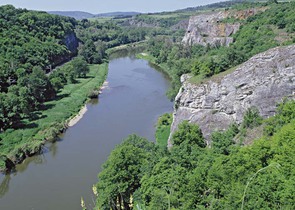Nature Conservation 2/2012 — 23. 8. 2012 — On Nature in the Czech Republic — Print article in pdf
Hausmannová I., Heřman P., Jančaříková I., Ložek V., Mottl J., Moucha P., Slezák M., Tichý T., Urban

A romantic landscape of limestone rocks and huge forest between Prague and Beroun, with the Berounka River being its natural axis and the Gothic Karlštejn Castle its conspicuous landmark, was declared the Protected Landscape Area (PLA) just forty years ago.
Nevertheless, the first proposals to protect natural values and beauties in the Karlštejn Castle area by establishing a Nature Reserve had appeared in the beginning of the 20thcentury. The above part of the current PLA began to be legally protected in 1932, while the whole landscape unit called the Český kras/Bohemian Karst has been under protection as the PLA since April 12, 1972. The Český kras/Bohemian Karst is the largest limestone area in Bohemia, displaying a unique morphology. It became famous worldwide due to the occurrence of fossils. There are a lot of instructive geological outcrops there: the location of the Global Boundary Stratotype Section and Point (GSSP) which marks the boundary between the Devonian and Silurian periods on the geologic time scale at Klonk near Suchomasty is the most important. Together with other factors, e.g. warm lowlandsituated in the Krušné hory/Ore Mts. and Brdy Highlands rain shadow and long-term use of the landscape by humans, it is limestone substrate which determines patterns of flora within the area. Also from a point of view of zoology, the Český kras/Bohemian Karst is one of the species-richest and most significant regions in the Czech Republic. Nature conservation measures in the field particularly include grazing and mowing at the most valuable sites. Nature and the landscape in the Český kras/Bohemian Karst may be affected by an intensive pressure for building-up the area and using it for tourism, caused by the location of the PLA relatively close to Prague, limestone mining and, the most recently, interest of multinational corporations to carry out geological survey for schist natural gas and oil.

